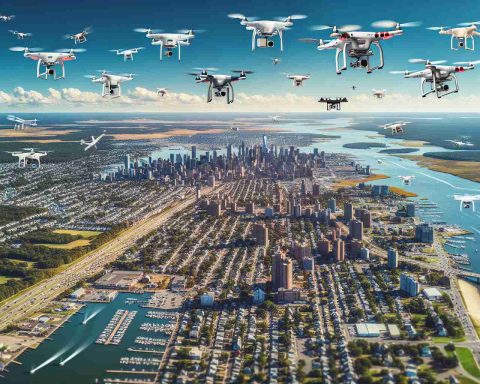In a recent announcement, Taiwan’s Ministry of Digital Affairs revealed that two crucial undersea cables linking the Matsu Islands to the main island were severed due to what is described as “natural deterioration.” This disruption prompted officials to activate backup communication systems to maintain some level of connectivity for the islands’ approximately 14,000 residents.
During an official briefing, Deputy Digital Minister Chiueh Herming explained that the cables were completely offline earlier in the day, with full restoration expected by the end of February. To mitigate the impact, the government has turned to microwave communications to help restore internet access partially.
Chiueh noted that, as of this incident, no suspicious vessels were detected in the vicinity when the cables went down, although he did acknowledge a rising trend in ship-related damages to undersea communications. In fact, Taiwan has recorded four such malfunctions in 2025 alone, marking an increase from previous years.
Tensions surrounding these undersea cables are heightened, given ongoing concerns about Chinese operations in the region. Just earlier this month, a Chinese-linked vessel was suspected of damaging another underwater cable, which the owners and the Chinese government have contested. To safeguard its infrastructure, Taiwan has considered deploying its navy to deter any suspicious activities.
These events underscore Taiwan’s commitment to fortifying its communication systems in the face of potential threats, including the exploration of satellite technology as a means to bolster connectivity in remote areas like Matsu.
The Fragile Threads of Connectivity
The recent severing of undersea cables linking Taiwan’s Matsu Islands to the mainland underscores the intricate relationship between technology and geopolitics. In an era where communication infrastructure is considered vital to social stability and economic growth, such disruptions not only affect local residents but also reverberate through the broader societal and global economic fabric.
With roughly 14,000 residents relying on these cables for internet and communication access, their severance highlights the vulnerability of remote communities. The swift activation of backup systems, including microwave communication, reflects a critical need to adapt quickly in the face of technological failures, especially in isolated regions that traditionally rely on undersea cables.
Moreover, environmental implications of these disruptions cannot be overlooked. The increase in incidents linked to naval activities indicates a potential intersection between maritime operations and communication technology, raising questions about the environmental impact of damaged habitats in undersea ecosystems.
As global reliance on digital infrastructure intensifies, the frequency of these incidents may shape future trends. Taiwan’s response—considering naval deployments and the integration of satellite technology—could serve as a model for other nations navigating similar geopolitical landscapes. Ultimately, the long-term significance lies in how effectively societies adapt to emerging threats and reinforce their communication infrastructures in this complex, interconnected world.
Undersea Cable Disruption: Taiwan’s Digital Resilience in the Face of Natural Deterioration
Overview of the Incident
In early October 2023, Taiwan’s Ministry of Digital Affairs announced a significant disruption to communication services impacting the Matsu Islands due to the severing of two key undersea cables. The disruption, attributed to “natural deterioration,” affected the connectivity of approximately 14,000 residents living on the islands. As a response to this emergency, officials swiftly activated backup communication systems to maintain connectivity.
Restoration Efforts
During a briefing, Deputy Digital Minister Chiueh Herming emphasized that the cables were entirely offline and are expected to be fully restored by the end of February 2024. To mitigate the inconvenience caused by this disruption, the Taiwanese government has implemented microwave communications, serving as a temporary solution to restore partial internet access for residents.
Rising Concerns About Undersea Cable Security
While investigating the incident, it was noted that there were no unusual vessel activities recorded in the vicinity of the cable cuts. However, Chiueh acknowledged a notable increase in ship-related damages to undersea communications, with Taiwan recording four similar incidents in 2025 alone, a troubling rise compared to previous years.
Geopolitical Tensions and Cable Vulnerability
The vulnerability of these undersea cables is further exacerbated by ongoing geopolitical tensions, particularly regarding Chinese operations in the region. Earlier in October, a Chinese-linked vessel was implicated in the damage of another underwater cable, spurring discussions about the necessity of increasing naval patrols to safeguard Taiwan’s critical communication infrastructure.
Future Measures and Innovations
To enhance the resilience of its communications systems, Taiwan is actively exploring new technologies, including satellite communication. This initiative aims to establish reliable connectivity for remote regions, particularly the Matsu Islands, which are susceptible to disruptions due to their geographical isolation.
FAQs
Q: What caused the disruption of communication services to the Matsu Islands?
A: The disruption was caused by the severing of two undersea cables due to “natural deterioration.”
Q: How does Taiwan plan to restore connectivity?
A: Taiwan is using microwave communications as a temporary measure while working on restoring the undersea cables, expected to be fully operational by the end of February 2024.
Q: Are there concerns about security regarding undersea cables?
A: Yes, concerns have been raised about ship-related damages to undersea cables and potential threats from nearby Chinese operations.
Pros and Cons of Current Measures
Pros:
– Quick response with backup communication systems in place.
– Implementation of microwave communications provides immediate relief.
– Exploration of satellite technology for future resilience.
Cons:
– Full restoration of undersea cables may take several months.
– Rising frequency of cable damage incidents raises long-term concerns.
– Geopolitical tensions may pose ongoing risks to underwater infrastructure.
Conclusion
The severing of undersea cables linking the Matsu Islands to Taiwan underscores the vulnerabilities inherent in digital communication infrastructure. Despite the natural causes behind the incident, the geopolitical climate and increasing frequency of cable damage incidents necessitate robust security measures and innovative solutions like satellite communications to ensure the continued connectivity and safety of Taiwan’s remote regions. For more information on Taiwan’s efforts in digital infrastructure, visit Digital.gov.tw.




















